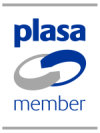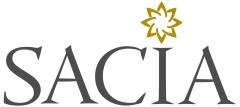27 September 2010
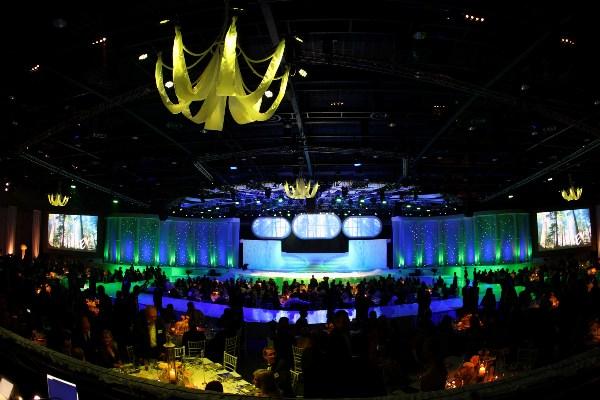 Story courtesy Louise Stikland and photos by Duncan Riley Gearhouse South Africa supplied design and technical production – including rigging, lighting, visuals, AV set and audio – to the 2010 Annual Bidvest Chairman’s Awards, one of South Africa’s highest profile corporate events, staged at Sandton Convention Centre (SCC) Johannesburg.
Story courtesy Louise Stikland and photos by Duncan Riley Gearhouse South Africa supplied design and technical production – including rigging, lighting, visuals, AV set and audio – to the 2010 Annual Bidvest Chairman’s Awards, one of South Africa’s highest profile corporate events, staged at Sandton Convention Centre (SCC) Johannesburg.
Tim Dunn designed the spectacular set, visuals and lighting for the 3 day event, which encompassed the strongly feminine 2010 “Bidvest Eve” theme and comprised a curvaceous, completely white 73 metre wide set with multiple synchronised revolves and dramatically sweeping spiral staircases as its centrepiece.
Dunn lit the environment almost entirely with energy saving LED lightsources. At the essence of his design was the ability to colour, texture and transform the space with lighting and visual effects – utilizing the very specific qualities of light that is output from LED fixtures, fused with beautifully fluid ambient video projections, making it dynamic, interesting and different.
He collaborated closely with show directors and co-producers David Bloch and Debbie Rakusin, plus all Gearhouse’s different disciplines and departments, creating detailed drawings and technical plans in advance to ensure that everything ran smoothly and efficiently on site.
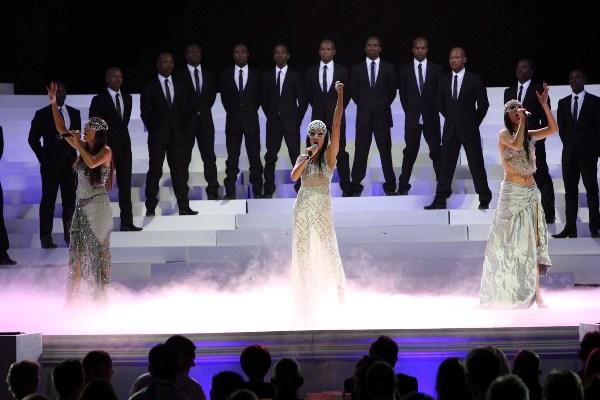
According to Rakusin, who also choreographs all the show’s dance and movement elements and has been onboard for many years, “It is always a great pleasure to work with the Gearhouse team. They have become friends, which makes for a very comfortable and productive space, allowing us to overcome the deadline stresses and deliver a beautiful show.”
This is Dunn’s fourth year of working on Bidvest. Each year, it is a major pressure to create a new, completely different, visually provocative space in which the clients can stage their own slick presentation, which this year featured numerous live performers and a fashion show in addition to the gala dinner for 1000 international guests each night.
Set
Gearhouse’s set building specialists SDS constructed all the set elements in an operation co-ordinated by Pieter Joubert and Craig Pretorius. This year, all technical departments had 2 days less build time than previously, a compressed timescale that added to the many challenges whilst producing some class teamwork.
The main performance stage was an 18 metre revolve supplied by Gearhouse In2structures, on top of which were two 7.8 metre revolves, each with a huge spiral staircase measuring 3 metres wide by 3.1 metres high.
These spiral staircases were linked to a static central staircase, so the movement of the smaller revolves had to be 100% precise so all pieces lined up correctly at the required moments. The revolves were used for artist and presenter entrances and exits and for the numerous scene changes running throughout the event.
The main stage was flanked with two 18 metre by 4 metre secondary stages; each featuring a set of majestic Romanesque columns at the back. Tensioned between the headers of theses pillars and the centre stage area was a 6 metre by 24 metre white sharkstooth gauze. This was front lit to give additional depth and dimensionality, and backed with a 24 metre by 6 metre LED starcloth.
A massive “U” shaped fashion ramp/runway curved out from the stage into the front section of the audience, which was seated on an 1800 square metre seating platform, so the performers could get close up and interact with the guests. The ramp was finished in an imported high gloss Marley, creating an additional lighting surface within the audience.
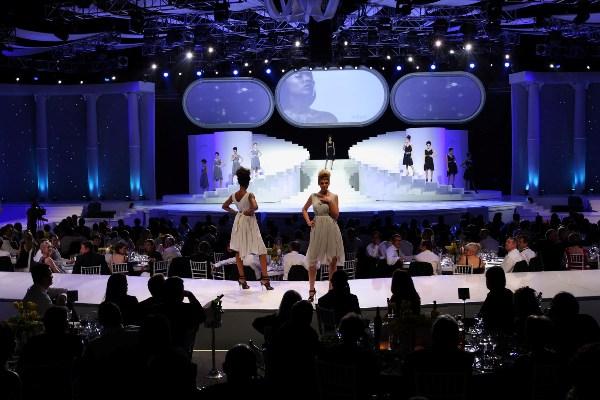 Sightlines around the room were integral to Dunn’s design. When drawing up the final versions, he meticulously checked the viewing angles from all the tables in the room to ensure that every guest would have an excellent view of the action for their maximum enjoyment.
Sightlines around the room were integral to Dunn’s design. When drawing up the final versions, he meticulously checked the viewing angles from all the tables in the room to ensure that every guest would have an excellent view of the action for their maximum enjoyment.
Three printed oval screens were suspended above the centre revolve, each angled backwards and edged by an integral printed “3D” picture frame. Dunn commissioned the Gearhouse Media team to create special AV content and masks that made these “windows” constantly shifting 3D visual illusions. Left and right of the main stage were two 10 metre by 7 metre 16:9 format projection screens, used for camera IMAG footage, with the same printed effect as the oval centre screens.
Suspended over the audience were 7 opulent chandeliers, graciously swagged in silks and internally lit. These were also custom designed and built by SDS, and functioned as eye-catching house lights.
Lighting
A matt white painted set finish can be a difficult surface to light, but it gave Dunn a completely blank canvas to show just what can be achieved with imagination and intelligent application of some very specific tools, to produce all the requisite glamour and glitz for the occasion.
All the lighting fixtures were hung on a series of trusses flown in the roof – by the Gearhouse Rigging team led by Kendall Dixon – arranged in curves matching the shape of the stage and radiating out from it above the seating areas. These were connected – outer to inner sections – with a series of white silk panels threaded through the top rails, making a real ceiling feature and adding another architectural element to the space. There were 186 rigging points in the roof and 96 motors.
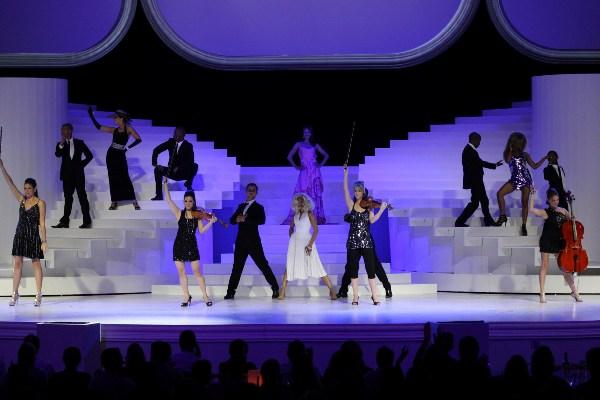 Dunn has been using LED lightsources increasingly in his recent designs, and has devoted considerable time to experimenting with the effects and colours on different surfaces and in different situations, exploring a myriad of possibilities.
Dunn has been using LED lightsources increasingly in his recent designs, and has devoted considerable time to experimenting with the effects and colours on different surfaces and in different situations, exploring a myriad of possibilities.
For the size of the room and set, the lighting rig was not exceptionally large and every fixture was multi-functional and maximized. He used 42 Robe REDWash 3●`193 LED wash lights, 24 Vari*Lite VLXs, 14 i-Pix BB4s and 108 i-Pix Satellites, 48 LED PARs and 24 Robe CitySkape48s. The only discharge light sources were 38 x Martin Professional MAC 2K Profile moving lights.
Balance was a key word – all levels had to be matched and appropriate and complement the video scenery!
The VLXs were positioned upstage and used for back lighting and also for most of the show’s key lighting. The REDWashes showed their real power and versatility in toning the set with a wide spectrum of colours from subtle pastels to bold saturates. The MAC 2Ks – also the only fixture with a gobo – were used for beautiful beamy looks and specials, their arc lightsources introducing a completely contrasting texture of lighting into the mix, adding drama and perspective.
The i-Pix satellites were used to up-light the columns and the ceiling cloths, while the BB4s and CitySkapes lifted the gauzes in front of the starcloth and behind the pillars. Sixty ETC Source Four PARs were used to light the stair ramps, and Griven Colorados were positioned to up-light the chandeliers from the floor, highlighting their lavish silk draping. The chandeliers were also internally lit with LED PARs, their reflected light bouncing around the room.
The complex amalgamation of lighting styles united traditional theatre and classic TV elements with new ideas, contemporary presentation and the excitement of new technology.
Dunn programmed and ran the show on an MA Lighting grandMA full size console, complete with another for backup, running on a fibre network. As is often the case, he worked closely with lighting director Hugh Turner and with Marcel Wijnberger and Chris Grandin from Gearhouse media, all of whom comprised his FOH team.
Video & AV
It was a video intensive show, with pre-recorded playback, ambient content and IMAG running throughout the 3 hour performances.
Grandin operated a Wings system, which consisted of 3 slave servers triggered by one master, which stored all the timecoded based show playback tracks. Video content for the oval screens was stored on 2 grandMA VPUs triggered from Dunn’s grandMA console. All these, together with additional playback footage on a Grass Valley Turbo hard drive – were fed into the Christie Vista Spyder X20 switcher operated by Grandin and output to screen.
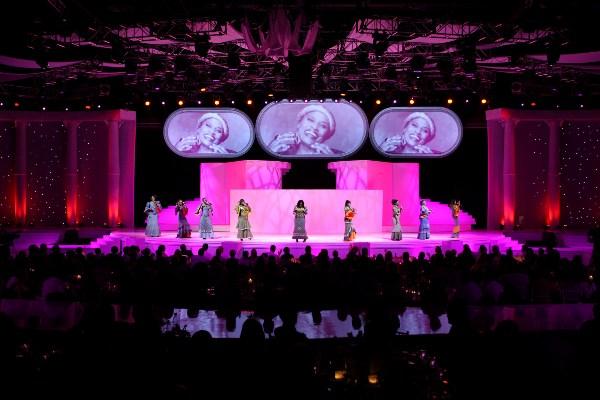 The oval screens primarily featured atmospheric content – including natural elements like clouds, stars, the moon, waterfalls, etc., – things you might see out of a window, all specially edited for the show from Gearhouse Media’s stock extensive library. It was compiled by Dunn and Wijnberger over about 5 days once they knew the format and running order of the show, which was in 3 acts – Fashion, Jewels and then the Bidvest Eve show complete with live performers.
The oval screens primarily featured atmospheric content – including natural elements like clouds, stars, the moon, waterfalls, etc., – things you might see out of a window, all specially edited for the show from Gearhouse Media’s stock extensive library. It was compiled by Dunn and Wijnberger over about 5 days once they knew the format and running order of the show, which was in 3 acts – Fashion, Jewels and then the Bidvest Eve show complete with live performers.
The screens were all run in full HD, fed by projectors mounted on the roof trusses – the side screens each via double stack of Christie 18Ks and the oval screens with 3 double stacks of Christie 10Ks. Christie’s “Twist” software was used to warp the oval screen content into the correct perspective. They were also all lined up wirelessly using Christie Road Tools, which was physically very practical and saved large amounts of time. The projection system was run over a fibre cable to the Spyder.
Cameras and an OB truck were supplied – as a completely different entity – by Obeco – who sent a TX camera to the Wings system for outputting primarily to the side screens. Playback content appeared throughout the show on the oval screens and sometimes on the sides.
Audio
Gearhouse Audio was led by Andreas Furtner, who had also done last year’s show in the same venue. This year they had a mix of playback and live tracks, so Furtner chose an L-Acoustics Kudo system for its clear and refined sound and directivity, as the client wanted the sound to actually emanate from the specific areas of the set where the action was happening.
Three hangs each of 6 Kudos graced the left, centre and right areas of the set, positioned between the secondary stages and the set.
Eight L-Acoustics SB28 subs were used to enhance the atmospheric sounds, placed left and right of the set and centre stage, and under the side screens. Eight Nexo PS10-R2s were used for front fill where necessary across the front of the set.
Monitors were L-Acoustics HiQ wedges. Four were flown off the trusses to give a general stage monitor ‘wash’ for dancers and playback artists, with another 4 in traditional positions around the front of the stage for the live acts. The side stages had a wedge each, with 2 more wedges onstage for the live piano act, making 12 in total. Many of the individual artists used the Sennheiser G2 IEMs that were supplied.
Monitors were mixed by Ezekiel Maharora Mashimbye using a Yamaha M7 and all the desks onboards.
Stage/patch tech Sanele Freedom Gumede received a technical IEM mix back to monitor city, ensconced behind the set, which he shared with Nathan Thiart who co-ordinated all the wireless components, 22 Shure UHF R-Series mics & beltpacks, 8 units of Sennheiser G2 and 8 channels of Clearcomm RX/TX comms.
The main system amplifiers were networked LA8s, with the onboard processing fully utilized for crossovers, delay, EQ and fine tuning. LA 24s drove the monitors.
Furtner chose a Yamaha PM5D console to engineer the FOH mix. He utilised all of the console’s onboard processing and effects, and wrote audio scenes for each section of the show.
Another challenge was making the various audio track sources – all recorded at different times and under different circumstances – have a uniform sound quality. All the playback tracks were stored on the Wings servers and synched to various video footage and animations, and Furtner received a left and right send to balance.
Bidvest 2010 was another resounding success. Debbie Rakusin admits that this job is probably the highlight of her year as she and David Bloch get the freedom to create and produce. “I am eternally grateful for the opportunity given us by Brian Joffe and Dave Koff of Bidvest to produce such magnificent shows – and with Gearhouse as our support on their side of things, we can’t go wrong. What a brilliant team!”
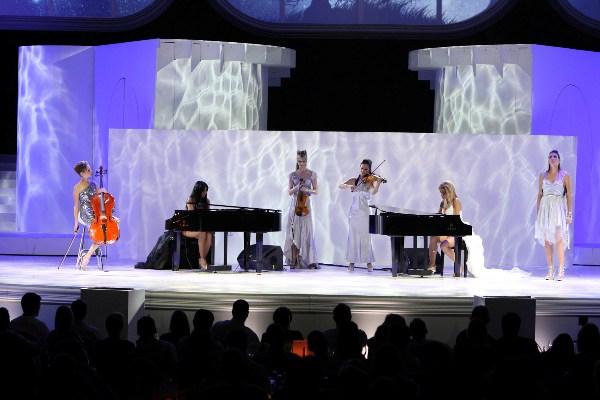 This year’s schedule was extremely tough, especially for Gearhouse Lighting and Media, resulting in a technical and production masterpiece that highlighted the company’s ability to pool the talents, expertise and resources from its various components, and create an epic production that looked fantastic and was practical to deliver.
This year’s schedule was extremely tough, especially for Gearhouse Lighting and Media, resulting in a technical and production masterpiece that highlighted the company’s ability to pool the talents, expertise and resources from its various components, and create an epic production that looked fantastic and was practical to deliver.
‘Under the incredible management of Pieter Joubert, SDS, Gearhouse and the entire team have once again exceeded our expectations in delivering an incredible product. Nothing is too much trouble for them!” enthuses Bloch, who concludes “This was one of the most ambitious Bidvest events ever produced, and Gearhouse was a major contributor in its success. Bidvest CEO Brian Joffe and many of our guests considered this to be the best Bidvest event to date. Gearhouse is a valued member of our team and we fully appreciate the hard work, creative input, exceptionally long hours, disastrous deadlines and extreme pressures under which everyone has to work. Believe me, it does not go unnoticed!”


